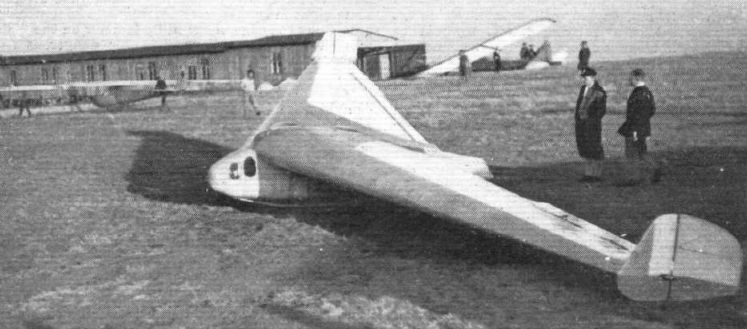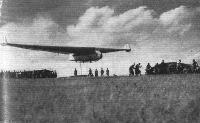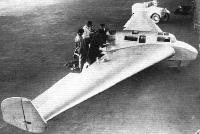
M.Simons The World's Vintage Sailplanes 1908-45
THE STORCH SERIES
<...>
The end of the Storch series came with the Delta 1, named Hermann Koehl, which flew in 1931 first as a two-seat sailplane with the pilot and passenger seated in tandem, in a central nacelle with windows. Later the nacelle was rebuilt as a cabin for two, and a 30 hp motor was added together with a tricycle undercarriage.
Lippisch’s experiences greatly influenced the Horten Brothers when they began experiments with flying wing gliders, and Lippisch himself continued his researches for many years.
Technical data:
Delta I (sailplane): Span, 13.24 m. Wing area 26.70 sq m. Aspect ratio 6.56.
Описание:
- M.Simons The World's Vintage Sailplanes 1908-45
- Flight, October 1931
The New German "Tailless"
Фотографии
-
Flight 1930-09 / Flight
Another view of the tail-less machine before the engine has been put in. This machine was only built after exhaustive tests with models, and has an estimated top speed of 110 m.p.h. The wing-tip fins and rudders are of a thick aerofoil section and also act as skids. The pilot's view seems to be negligible.
-
Flight 1930-09 / Flight
The tailless machine of the R.R.G. being tried out as a glider.
-
Flight 1931-10 / Flight
A BIRD'S EYE VIEW: The trailing edge flaps are divided into elevators and ailerons.
The Lippisch Delta I of 1930 was so called because of its swept-back leading edge and straight trailing edge. -
История Авиации 23 / Д.Городничий - Ракетная рапира Люфтваффе /Самолеты второй мировой/ (1)
"Дельта I" на берлинском Аэродроме Темпельхоф.
-
Flight 1931-09 / Flight
A NEW TAILLESS AIRCRAFT: Herr Lippisch, chief designer of the Rhon-Rossitten Ges., has produced this new tailless aircraft at the Wasserkuppe. After considerable trials as a glider it was fitted with a Siemens engine and has now been taken by Herr Koehl, of trans-Atlantic fame, to Berlin. It is exceptionally clean and highly efficient as one would expect from the designer of the world's most successful gliders such as the Wien and the Fafnir.
-
Flight 1931-10 / Flight
IN FLIGHT: The port rudder is seen swung outward to make the machine steer to the left.
-
Aeroplane Monthly 1983-07 / R.Olejnik - Messerschmitt's Mighty Midget (1)
The Delta I, powered by a Bristol Cherub. First powered flights were made early in 1931.
-
Flight 1931-10 / Flight
THE "HERMANN KOHL": This view from below gives a good idea of the plan form of the tailless machine
-
Aviation Historian 38 / G.Inchbald - Outside edge
Research into unusual flying shapes, particularly the tailless aircraft and delta wing, was advanced in pre-war Germany by designers including Alexander Lippisch. He designed the Delta I for the Rhoen-Rossitten Association gliding club, which flew with a Bristol Cherub engine, as seen here, in 1931. Note the fins with rudders attached to the wingtips.
-
Flight 1931-10 / Flight
THE THREE-WHEELED UNDERCARRIAGE: The front wheel is steerable.
-
Flight 1931-10 / Flight
THE POWER PLANT: The engine is a Bristol "Cherub" driving a pusher airscrew.
-
Мир Авиации 1996-02 / К.Косминков, Н.Валуев - Немецкое влияние /Страницы истории/ (1)
Двухместный легкий самолет "Дельта-I" (А.Липпиш, 1931г.)
-
Air Enthusiast 1996-07 / A.Pelletier - Towards the ideal aircraft? (1)
Lippisch Delta I.
- Фотографии














